Football, often dubbed “the beautiful game,” is a spectacle filled with moments of individual brilliance, teamwork, and stunning goals. Each goal represents a culmination of skill, strategy, and sometimes sheer luck. While many appreciate the artistry in passing and defense, it’s the act of scoring that truly captivates fans worldwide. German journalist Javier Cáceres has taken this concept to a remarkable level by documenting the memories and interpretations of football legends through hand-drawn sketches of their most cherished goals.
Cáceres first conceived his project nearly two decades ago during an interview with former Chilean international Leonel Sánchez. After Sánchez sketched a memorable goal from the 1962 World Cup, Cáceres recognized something profound: the act of drawing could lead to deeper storytelling. It wasn’t just about recalling a significant moment; it was about expressing the emotions and details tied to that memory. This observation inspired Cáceres to invite other football icons to illustrate their own favorite goals, creating a personal narrative that intertwined visual art and sport.
By gathering sketches from football luminaries such as Pelé, Franz Beckenbauer, and Bobby Charlton, Cáceres not only preserved these moments but also revealed underlying stories behind each goal. The sketches serve as a reflection of each player’s style and perspective, adding depth to the appreciation of their skill and contributions to the game.
Memorable Turns on the Pitch
One of the most notable entries in Cáceres’ book, titled “Tore Wie Gemalt” (“Goals as Portraits”), features Jorge Valdano’s iconic strike during the 1986 World Cup final. Assisted by none other than Diego Maradona, Valdano’s goal was more than just a point on the scoreboard; it was the essence of victory on a global stage. Valdano’s artistic representation extends beyond mere technicality; it embraces the ethos of football, making it clear that every goal carries an unspoken narrative filled with history and significance.
Cáceres emphasizes this notion of storytelling by noting how players often draw upon memories that are not widely known. The sketches translate technical aspects into emotions, allowing fans to connect with the game in an entirely different way. For instance, Valdano’s elaborate drawing of the entire pitch, filled with every nuance of the play, indicates a profound commitment to recounting the moment accurately.
One of the intriguing aspects of this project is the variety in how players approach their sketches. Pep Guardiola, known for his meticulous nature, created a highly detailed drawing from his memory of a long-ago goal. The precision in his representation is striking and speaks volumes about his analytical mind, reflecting how his football philosophy extends even to the representation of his past.
In stark contrast, Xavi Hernández’s artistic style was more abstract, utilizing stick figures and embellished sketches that highlight the fluid movement and collaborative nature of football. Xavi’s drawing of a memorable lob over Iker Casillas during El Clásico not only encapsulates a critical moment for the player but also celebrates the artistry involved in teamwork and execution. Their differing styles portray not only their personalities but also how the beautiful game inspires various interpretations.
Significant Moments etched in Time
Cáceres’ collection is enriched by memorable goals from tournament history, including Xabi Alonso’s famous penalty in the 2005 Champions League final. This goal, built on the foundation of persistence and urgency, demonstrates how every detail, even minor circumstances such as a goalkeeper’s attributes, can influence a player’s memory. Such anecdotes surrounding the goals provide additional layers of appreciation, reminding fans that behind every moment of brilliance lies a rich tapestry of experiences.
Contemporary players have also found their place in Cáceres’ collection—one notable entry comes from Kai Havertz, who illustrated his decisive goal in Chelsea’s 2021 Champions League victory. The draw of capturing one’s “best” goal is a common sentiment among players, leading many to feel their prime scoring moments are still on the horizon. Havertz’s drawing of this highlight indicates not just personal achievement, but also the weight of history playing out on the field.
Despite the breadth of Cáceres’ collection, certain legendary figures remain elusive. Attempts to include Diego Maradona and Johan Cruyff have not materialized, thus leaving certain narratives unfinished. Cáceres recounts a near encounter with Maradona, illustrating the unpredictability associated with the late icon’s larger-than-life personality. Such stories add an element of mystique to the project, reinforcing the idea that the essence of football extends beyond just the goals scored; it encompasses the lives and legends of those who have transformed the game over decades.
Javier Cáceres’ project is a beautiful junction of football, art, and storytelling. By compiling drawings from some of the game’s greatest ambassadors, he offers a unique lens through which fans can appreciate the history and significance of scoring. Each sketch serves as a tribute to the passion, intricacies, and unforgettable moments that define football, transcending mere statistics to celebrate the artistry of the game itself. In every goal, there lies a story waiting to be told, a journey that is just as important as the destination.

